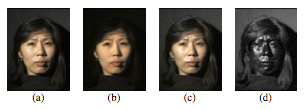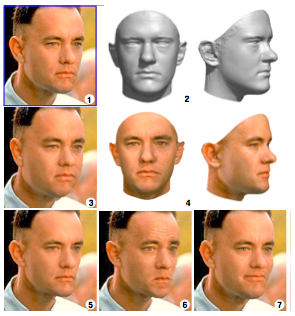Digital look-alikes
When the camera does not exist, but the subject being imaged with a simulation of a (movie) camera deceives the watcher to believe it is some living or dead person it is a digital look-alike.

(a) Normal image in dot lighting
(b) Image of the diffuse reflection which is caught by placing a vertical polarizer in front of the light source and a horizontal in the front the camera
(c) Image of the highlight specular reflection which is caught by placing both polarizers vertically
(d) Subtraction of c from b, which yields the specular component
Images are scaled to seem to be the same luminosity.
Original image by Debevec et al. – Copyright ACM 2000 – http://dl.acm.org/citation.cfm?doid=311779.344855 – Permission to make digital or hard copies of all or part of this work for personal or classroom use is granted without fee provided that copies are not made or distributed for profit or commercial advantage and that copies bear this notice and the full citation on the first page.

(1) Sculpting a morphable model to one single picture
(2) Produces 3D approximation
(4) Texture capture
(3) The 3D model is rendered back to the image with weight gain
(5) With weight loss
(6) Looking annoyed
(7) Forced to smile Image 2 by Blanz and Vettel – Copyright ACM 1999 – http://dl.acm.org/citation.cfm? doid=311535.311556 – Permission to make digital or hard copies of all or part of this work for personal or classroom use is granted without fee provided that copies are not made or distributed for profit or commercial advantage and that copies bear this notice and the full citation on the first page.
In the cinemas we have seen digital look-alikes for over 15 years. These digital look-alikes have "clothing" (a simulation of clothing is not clothing) or "superhero costumes" and "superbaddie costumes", and they don't need to care about the laws of physics, let alone laws of physiology. It is generally accepted that digital look-alikes made their public debut in the sequels of The Matrix i.e. w:The Matrix Reloaded and w:The Matrix Revolutions released in 2003. It can be considered almost certain, that it was not possible to make these before the year 1999, as the final piece of the puzzle to make a (still) digital look-alike that passes human testing, the reflectance capture over the human face, was made for the first time in 1999 at the w:University of Southern California and was presented to the crème de la crème
of the computer graphics field in their annual gathering SIGGRAPH 2000.[1]
“Do you think that was Hugo Weaving's left cheekbone that Keanu Reeves punched in with his right fist?”
Extremely unfortunately for the humankind, organized criminal leagues, that posses the weapons capability of making believable looking synthetic pornography, are producing on industrial production pipelines synthetic terror porn¹ by animating digital look-alikes and distributing it in the murky Internet in exchange for money stacks that are getting thinner and thinner as time goes by.
These industrially produced pornographic delusions are causing great humane suffering, especially in their direct victims, but they are also tearing our communities and societies apart, sowing blind rage, perceptions of deepening chaos, feelings of powerlessness and provoke violence. This hate illustration increases and strengthens hate thinking, hate speech, hate crimes and tears our fragile social constructions apart and with time perverts humankind's view of humankind into an almost unrecognizable shape, unless we interfere with resolve.
For these reasons the bannable raw materials i.e. covert models, needed to produce this disinformation terror on the information-industrial production pipelines, should be prohibited by law in order to protect humans from arbitrary abuse by criminal parties.
Footnote 1. It is terminologically more precise, more inclusive and more useful to talk about 'synthetic terror porn', if we want to talk about things with their real names, than 'synthetic rape porn', because also synthesizing recordings of consentual looking sex scenes can be terroristic in intent.
See also in Ban Covert Modeling! wiki
See also in Wikipedia
- w:Human image synthesis describes the historic build up to digital look-alikes and lots of examples you can view.
- w:Light stage is an instrument to capture (among other things) the reflectance of the subject
References
- ↑ Debevec, Paul (2000). "Acquiring the reflectance field of a human face". Proceedings of the 27th annual conference on Computer graphics and interactive techniques - SIGGRAPH '00. ACM. pp. 145–156. doi:10.1145/344779.344855. ISBN 978-1581132083. Retrieved 2017-05-24.